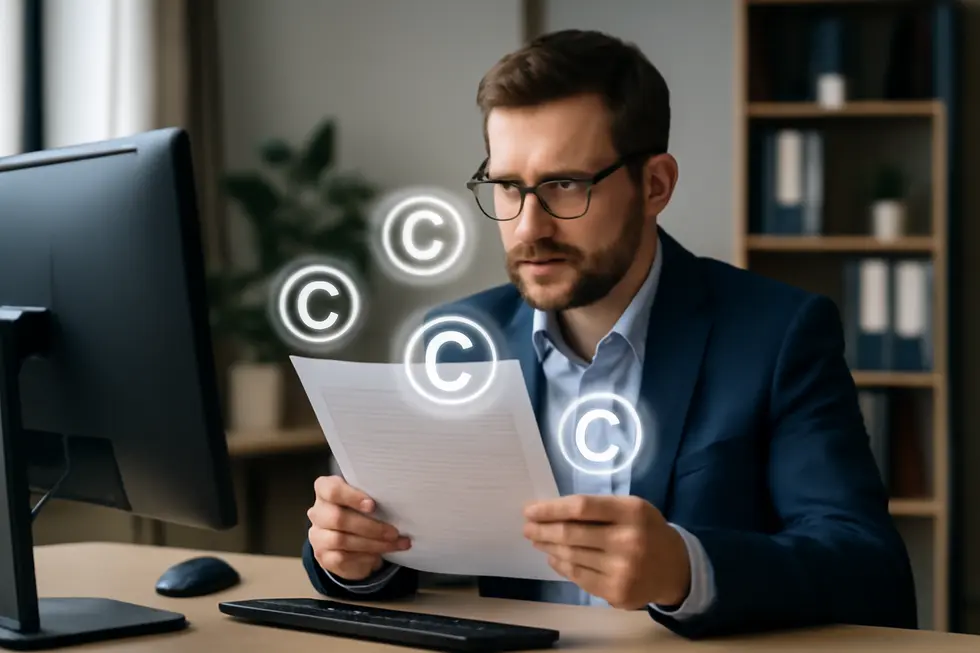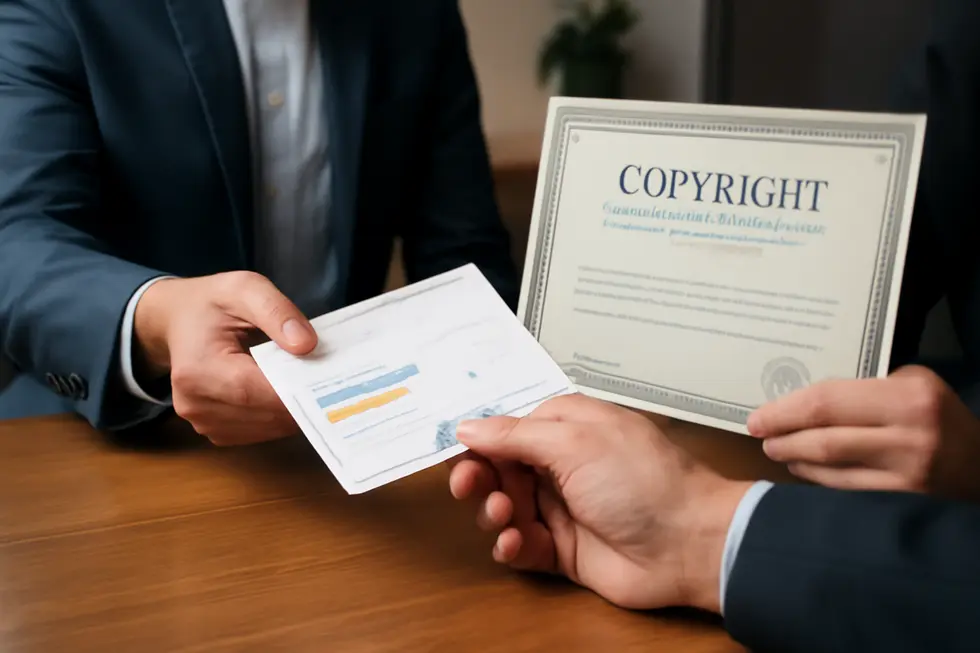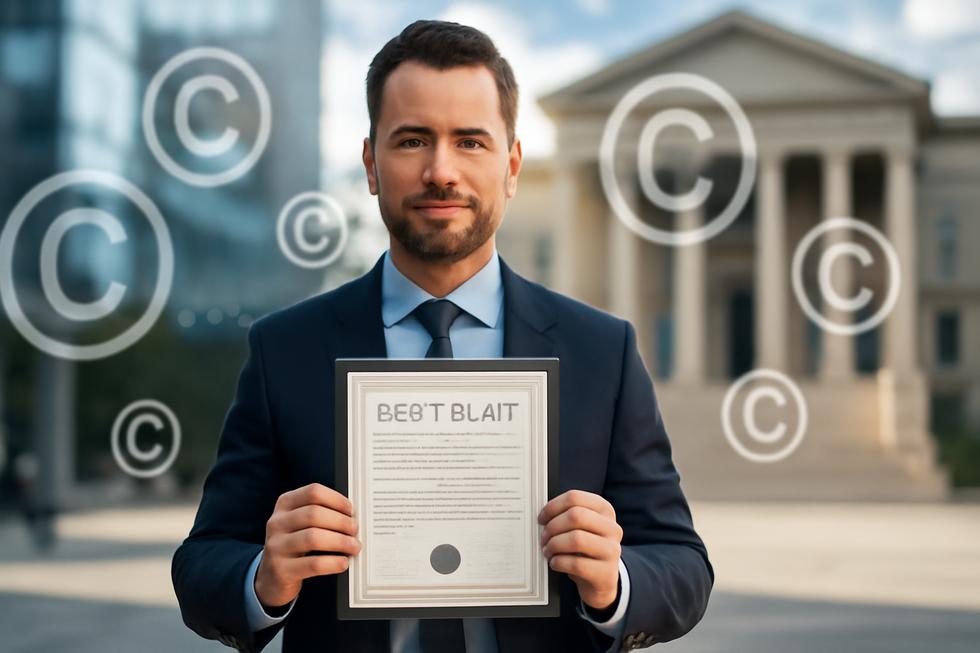Introduction
Copyright protection is a critical consideration for business owners who create original works—whether written, artistic, digital, or otherwise. Many entrepreneurs wonder whether they need to register their copyrights to secure or defend their intellectual property effectively. While copyright protection is automatic upon creation, registration plays a pivotal role in enforcement and accessing key legal remedies. Exploring the nuances between automatic protection, lawsuit eligibility, statutory damages, and public notice will empower businesses to make informed decisions about safeguarding their creative assets. Each chapter unpacks a core aspect of copyright registration, clarifying when registration is mandatory, recommended, or optional, and details the practical advantages of formal registration with the U.S. Copyright Office.
Tables of Contents
Chapter 1: Understanding How Automatic Copyright Protection Works Without Registration
- The Foundations and Limits of Automatic Copyright Protection Without Registration
- Beyond Automatic Rights: How Registration Enhances Copyright Enforcement and Legal Remedies
- How Copyright Registration Unlocks Legal Enforcement and Enhances Protection in the U.S.
- Global Automatic Copyright Protection Under the Berne Convention: How Registration Fits In
- Unlocking the Power of Copyright Registration: Key Practical Benefits and Strategic Considerations
Chapter 2: Does Copyright Need to Be Registered to Sue for Infringement?
- Why Registration Is the Essential Gateway to Copyright Lawsuits
- How Automatic Copyright Protection and Registration Work Together for Legal Enforcement
- Why Timely Copyright Registration Is Essential for Effective Legal Protection and Remedies
- Preregistration: Early Steps Toward Enforcing Copyright in Court
- Navigating Legal Enforcement: Why Timely Copyright Registration Unlocks Full Remedies
Chapter 3: Does Copyright Need to Be Registered to Access Statutory Damages and Attorney’s Fees?
- Digital Realities: Why Timely Copyright Registration Matters for Legal Remedies
- Why Timely Registration Unlocks Powerful Economic Benefits and Legal Remedies
- Global Legal Nuances and Geopolitical Impact of Copyright Registration for Litigation Benefits
- How Copyright Registration Shapes Enforcement, Economic Incentives, and Access to Justice
- Understanding Critical Legal and Timing Requirements for Copyright Registration Benefits
Chapter 4: Understanding Public Notice: Does Copyright Registration Establish It?
- How Automatic Copyright and Registration Create Public Awareness and Legal Record
- How Copyright Notice Functions as an Informal Public Warning of Ownership
- How Copyright Registration Enhances Legal Protection and Establishes a Public Record
- The Evolution of Copyright Formalities: How Pre-1989 Registration Shaped Public Notice and Protection
- How Registration Shapes Enforcement, Litigation Strength, and Public Awareness in Copyright Claims
Chapter 5: Does Copyright Need to Be Registered: Process and Benefits of Registration
- Legal Foundations of Copyright Protection: Automatic Safeguards and the Strategic Role of Registration
- Legal Proof and Enforcement Advantages: Why Copyright Registration Matters Beyond Automatic Protection
- Navigating Copyright Registration: Essential Steps and Key Advantages for Legal Protection
- Unlocking Value: Economic and Societal Benefits of Copyright Registration
- Unlocking the Strategic Advantages of Copyright Registration
Chapter 1: Understanding How Automatic Copyright Protection Works Without Registration

1. The Foundations and Limits of Automatic Copyright Protection Without Registration
Copyright protection applies automatically once an original work is fixed in a tangible form. This principle stems from international treaties like the Berne Convention, which eliminate the need for formal steps such as registration or notice to secure protection. Thus, authors hold exclusive rights to reproduce, distribute, and display their works immediately upon creation. However, automatic protection covers only the expression of ideas, not the ideas themselves. Registration remains optional but confers important advantages—especially legal proof and eligibility for statutory damages if timely filed. This built-in protection encourages creativity while registration serves as an enforceable record when disputes arise. For further insights on copyright fundamentals, see copyright definition and economics.
2. Beyond Automatic Rights: How Registration Enhances Copyright Enforcement and Legal Remedies
Copyright protection attaches automatically once an original work is fixed in a tangible medium, requiring no formal registration. However, registering with the U.S. Copyright Office confers vital legal advantages that go beyond automatic protection. Registration is a prerequisite to file infringement lawsuits in federal court and enables claimants to pursue statutory damages and attorney’s fees if registered within three months of publication or before infringement occurs. This official registration serves as a public record, strengthening ownership claims and deterring infringement. Additionally, it bolsters enforcement options, including leveraging provisions under the Digital Millennium Copyright Act (DMCA) for online protections. While automatic rights exist, registration significantly empowers creators to enforce and defend their copyrights effectively. For detailed guidance, see legal perspectives on protecting original ideas.
3. How Copyright Registration Unlocks Legal Enforcement and Enhances Protection in the U.S.
Copyright protection arises automatically the moment an original work is fixed in a tangible form. No registration is required to secure basic legal rights, making this instant protection a fundamental benefit for creators. However, registration with the U.S. Copyright Office transforms this protection from passive to enforceable. Without registration, a copyright owner cannot initiate infringement litigation in U.S. courts, limiting remedies to actual damages and lost profits, which are harder to prove. Timely registration—within three months of publication or before infringement—makes statutory damages and attorney’s fees available, incentivizing enforcement. Registration also establishes a public record of ownership, deterring potential infringers by signaling formal claim. While including a copyright notice is optional, it complements registration by notifying others of your rights and guarding against innocent infringement defenses. For more on copyright basics, see copyright information for books.
For official guidance on registration procedures and benefits, visit the U.S. Copyright Office website.
4. Global Automatic Copyright Protection Under the Berne Convention: How Registration Fits In
Copyright protection arises automatically the moment an original work is fixed in a tangible form, a principle firmly upheld by the Berne Convention, which unites over 170 countries. This international treaty requires member states to grant copyright protection without any formal registration or procedural step. Consequently, once a work is created and expressed in a fixed medium—whether written, recorded, or otherwise—it is protected in all Berne member countries automatically.
However, while registration is not a prerequisite for protection globally, it plays a crucial role in enforcement, especially in jurisdictions like the United States. Registration enables copyright owners to initiate infringement lawsuits and to claim statutory damages and attorney’s fees if filed timely. Moreover, it serves as official legal evidence of ownership, bolstering the owner’s position in disputes.
This balance between automatic protection and strategic registration is vital in understanding copyright rights internationally and domestically. For more insight on copyright scope and protection, refer to detailed copyright information for books.
For a comprehensive overview, see LegalZoom’s article on copyright registration and protection: https://www.legalzoom.com/articles/three-ways-to-protect-your-original-idea
5. Unlocking the Power of Copyright Registration: Key Practical Benefits and Strategic Considerations
Copyright protection arises automatically once an original work is fixed in a tangible form. Registration is not needed to secure these fundamental rights, but it dramatically strengthens enforcement capabilities. In the U.S., you must register before filing an infringement lawsuit, and registering within three months of publication unlocks statutory damages and attorney’s fees, otherwise unavailable. Registration also creates a public record, providing prima facie evidence of ownership and potentially deterring infringement. Many creators delay registration until publication to assess risk, but online registration is straightforward and affordable. While copyright notice is optional, using it alongside registration further informs the public of your claim. These practical benefits make registration a strategic tool beyond the automatic protection conferred at creation. For more detailed information, see protecting your intellectual property. To understand copyright’s implications in business contexts, exploring copyright language for business owners can be valuable.
Chapter 2: Does Copyright Need to Be Registered to Sue for Infringement?

1. Why Registration Is the Essential Gateway to Copyright Lawsuits
Registration serves as the crucial legal step required before filing a copyright infringement lawsuit in federal court. While copyright protection arises automatically once an original work is fixed in a tangible form, enforcement through litigation demands official registration or at least submission of the application. This process creates an authoritative public record that validates ownership and strengthens the claim in case of disputes. Furthermore, registering within three months of publication or before infringement enables eligibility for statutory damages and attorney’s fees—benefits unavailable to unregistered works. This registration prerequisite applies broadly across all creative works, including digital content and screenplays. For creators aiming to safeguard their rights and pursue legal remedies, timely registration is indispensable. For further detail, see why it is important to register a copyright.
2. How Automatic Copyright Protection and Registration Work Together for Legal Enforcement
Copyright protection begins automatically when an original work is fixed in a tangible form, granting creators exclusive rights from that moment without requiring registration. However, if a copyright owner wishes to enforce those rights through a federal lawsuit, formal registration with the U.S. Copyright Office is mandatory. Registration unlocks vital legal advantages: it allows filing infringement suits, enables recovery of statutory damages and attorney’s fees if filed within three months of publication or before infringement, and provides prima facie evidence of ownership when timely registered. Without registration, enforcement options are severely limited, even though the work remains protected by copyright law. This interplay between automatic protection and registration underpins the practical pathway for creators seeking to defend their rights. For more details, see copyright information example for business.
For official guidance on registration and its benefits, consult the U.S. Copyright Office: https://www.copyright.gov/registration/
3. Why Timely Copyright Registration Is Essential for Effective Legal Protection and Remedies
Early registration is a crucial step for copyright owners aiming to enforce their rights in court. Although copyright protection arises automatically upon creation, U.S. law requires registration with the Copyright Office before filing an infringement lawsuit. Registering within three months of publication or before infringement occurs unlocks powerful legal remedies, including statutory damages and attorney’s fees—benefits unavailable without timely registration. These statutory damages provide a fixed range of monetary compensation, simplifying enforcement without proving actual loss. Early registration also creates an official public record, strengthening ownership claims and potentially deterring infringement. Thus, securing a prompt copyright registration maximizes legal leverage for creators seeking to protect their works effectively. For more insight into the registration process, consult trusted legal resources such as Lee Law Services.
4. Preregistration: Early Steps Toward Enforcing Copyright in Court
Copyright protection begins automatically upon creation, but before suing for infringement, registration is legally required. Preregistration offers a limited early filing option for certain unpublished works, such as software, enabling rights holders to start the process before full registration is complete. However, this step alone does not authorize litigation until the official registration is finalized. Registration creates a public record that establishes ownership and unlocks eligibility for statutory damages and attorney’s fees—important remedies unavailable if registration is not timely filed. Without registration, owners can only pursue actual damages, which are harder to prove and often less substantial. Thus, preregistration helps safeguard emerging works but full registration remains crucial to enforce rights effectively in federal court. Learn more about copyright registration requirements for businesses. For detailed legal guidance, see the Lumenci article on copyright infringement claims.
5. Navigating Legal Enforcement: Why Timely Copyright Registration Unlocks Full Remedies
Although copyright protection exists from the moment of creation, the ability to enforce it through litigation hinges on registration. In the United States, you cannot file a federal lawsuit for infringement without first registering your copyright. Early registration—within three months of publication or before infringement—enables access to statutory damages and attorney’s fees, providing a stronger legal remedy beyond actual damages, which can be difficult to prove. Registration also creates an official public record, reinforcing your ownership claim and improving your negotiating position. Thus, timely registration is essential not only for filing suit but also for maximizing legal protections and enforcement efficacy. For further insights, see copyright language for business owners.
Chapter 3: Does Copyright Need to Be Registered to Access Statutory Damages and Attorney’s Fees?

1. Digital Realities: Why Timely Copyright Registration Matters for Legal Remedies
Copyright is automatically granted upon creation, yet in the digital realm, timely registration is crucial to access key legal remedies like statutory damages and attorney’s fees. The rapid online spread of digital content increases infringement risks, making registration vital to establish a public record and strengthen claims. Without registration, remedies are limited to actual damages, which are harder to prove and less effective against widespread digital piracy. Enforcement often depends on technical evidence and expert testimony, further emphasizing the need for formal documentation through registration. Automated monitoring aids detection, but legal power hinges on registered status, underscoring registration’s role as a protective keystone in the digital age. For more detailed legal context, see Lee Law Services.
[1] Lumenci – Explanation of statutory damages and legal recourse in copyright infringement cases.
2. Why Timely Registration Unlocks Powerful Economic Benefits and Legal Remedies
Copyright registration is essential to access statutory damages and attorney’s fees under U.S. law. Without registering your work before infringement or within three months of publication, you forfeit the right to claim these remedies and must rely solely on actual damages, which are often difficult to prove and less financially rewarding. Timely registration not only strengthens your legal position but also serves as a deterrent by enabling significant statutory damages—up to $150,000 per work in cases of willful infringement. For alleged infringers, this creates a strong incentive to respect copyrights, reducing infringement risks. Economically, enforceable copyrights encourage investment and innovation by protecting creators’ revenue streams. Ignoring enforcement may lead to reputational harm and operational setbacks. Thus, registration is a strategic step for financial and legal protection. For more detailed insights on copyright’s economic role, see copyright definition economics business.
Further legal analysis on statutory damages and enforcement.
3. Global Legal Nuances and Geopolitical Impact of Copyright Registration for Litigation Benefits
Copyright registration, while not mandatory for protection, serves as a critical gateway to statutory damages and attorney’s fees in the United States. This requirement creates significant geopolitical dynamics, as international creators and businesses must navigate differing national frameworks. Unlike the automatic protections under the Berne Convention, the U.S. system demands timely registration to fully enforce rights, influencing where companies choose to file lawsuits and protect their intellectual property. The potential for large statutory damages in U.S. courts affects innovation strategies and competitive positioning globally, particularly in cutting-edge fields like artificial intelligence. This disparity also raises concerns over national security and economic competitiveness in technology sectors, as firms weigh risks and benefits across jurisdictions. Multinational entities must therefore craft nuanced IP registration policies aligning with these divergent legal environments to optimize protection and litigation outcomes. For more insights on copyright’s role in business strategies, see copyright information for books. External resource: https://copyright.gov/help/faq/faq-basic.html
4. How Copyright Registration Shapes Enforcement, Economic Incentives, and Access to Justice
Copyright registration is pivotal for accessing statutory damages and attorney’s fees, fundamentally influencing how creative rights are enforced and valued. By creating an official public record, registration empowers creators to litigate more effectively, deterring infringement through the threat of substantial legal penalties. This financial leverage encourages investment in original works and timely registration, reinforcing the creative economy. However, the registration process presents barriers for smaller creators who may struggle with cost or awareness, potentially limiting their ability to secure comprehensive remedies. Furthermore, registration impacts litigation dynamics by raising stakes for infringers and shaping settlement tendencies, while also increasing transparency for licensing and dispute resolution. Such societal effects underscore registration’s dual role as both a protective and strategic tool within copyright law. For deeper insight, review this explanation on why copyright registration matters.
5. Understanding Critical Legal and Timing Requirements for Copyright Registration Benefits
Copyright protection exists automatically upon creation, but to access enhanced remedies like statutory damages and attorney’s fees, timely registration is crucial. Registration must occur within three months of publication or before infringement to qualify for these benefits. Without it, a copyright owner cannot bring a federal lawsuit or recover statutory damages, limiting remedies to actual damages and profits, which are harder to prove. This registration acts as public proof of ownership, easing the legal burden during enforcement. Notably, statutory damages range widely, with increased penalties for willful infringement. Thus, despite automatic protection, deferred registration restricts legal options, making prompt registration a strategic imperative for effective copyright enforcement.
For further details on copyright essentials relevant to businesses, see copyright information example business.
Reference: Detailed guidance from Ott Law Firm.
Chapter 4: Understanding Public Notice: Does Copyright Registration Establish It?

1. How Automatic Copyright and Registration Create Public Awareness and Legal Record
Automatic copyright protection arises the moment an original work is fixed in a tangible form, requiring no registration to exist or signal ownership publicly. Although placing a copyright notice (©, year, owner name) on a work is optional, it effectively alerts others to the claim and can deter infringement. Registration with the U.S. Copyright Office, while not needed to establish public notice, creates an official public record of ownership and strengthens the legal standing of the copyright. This formal record presumes the copyright’s validity in court and is required before filing an infringement lawsuit. Registration also unlocks remedies like statutory damages and attorney’s fees—benefits unavailable without timely registration. Thus, while copyright attaches automatically and notice is voluntary, registration strategically enhances public recognition and enforcement potential. For practical guidance, see copyright information for books.
Source: U.S. Copyright Office registration benefits and legal guidance.
2. How Copyright Notice Functions as an Informal Public Warning of Ownership
While copyright protection arises automatically upon creation, the inclusion of a copyright notice offers valuable informal public notice. Typically featuring the © symbol, the year, and the owner’s name, this notice clearly signals that a work is protected. It discourages unknowing infringement and points interested parties to the copyright holder. Although not legally required, such notices help demonstrate awareness of copyright ownership—potentially strengthening claims if legal disputes arise. However, this informal notice does not replace formal registration, which is necessary to initiate infringement lawsuits and access statutory remedies. Nonetheless, a visible copyright notice acts as an essential first step in asserting rights and fostering public awareness. For deeper insights on copyright language for business owners, see copyright language guidance.
Source: University of Michigan Library – Copyright Basics
3. How Copyright Registration Enhances Legal Protection and Establishes a Public Record
Copyright registration is not required to establish public notice, as protection begins automatically once a work is created and fixed. Nevertheless, registering your copyright creates an official public record that identifies the owner and the work, which can discourage infringement and resolve ownership disputes. Registration legally presumes copyright validity and ownership, strengthening your position in court if litigation arises. It is mandatory before filing a federal infringement lawsuit and enables claims for statutory damages and attorney’s fees if done promptly, within three months of publication or before infringement occurs. While a copyright notice informs the public about protection, registration provides crucial legal advantages for enforcement and record-keeping, crucial for creators seeking to safeguard their rights effectively. For deeper insights, consult the U.S. Copyright Office guidance.
4. The Evolution of Copyright Formalities: How Pre-1989 Registration Shaped Public Notice and Protection
Prior to 1989, U.S. copyright protection heavily relied on formalities like registration, copyright notice, and timely renewal. These requirements were crucial not only to maintain rights but also to provide clear public notice of ownership. For instance, works published between 1929 and 1963 needed a proper notice and had to be renewed after 28 years; failure meant automatic entry into the public domain. Registration was mandatory before pursuing infringement claims, enabling access to statutory damages and attorneys’ fees if completed promptly. Since the U.S. joined the Berne Convention in 1989, these formalities became optional for protection, though registration still strengthens enforcement. This shift from formal registration to automatic protection marked a pivotal change in how public notice and copyright rights operate. For more on historical copyright rules and records, see resources such as the U.S. Copyright Office Catalog.
5. How Registration Shapes Enforcement, Litigation Strength, and Public Awareness in Copyright Claims
Copyright registration is not required to secure protection or to establish public notice, but it significantly strengthens a creator’s ability to enforce rights and prevail in litigation. By recording ownership publicly, registration creates a legal presumption of validity that courts rely on during disputes. While a copyright notice (©, year, owner) is optional, it flags the work as protected and can deter unintentional infringement. Crucially, lawsuits for infringement cannot be filed without prior registration, and timely registration (within three months of publication or before infringement) unlocks statutory damages and attorney’s fees, potentially awarding up to $150,000 for willful violations. This enhances deterrence and supports stronger legal remedies, including injunctions and criminal penalties in severe cases. Though registration involves costs, its strategic benefits make it essential for works with commercial value or anticipated enforcement needs. For more on copyright rights and business implications, see copyright information example for businesses.
For detailed legal contexts and remedies, refer to Lexology’s guide on legal presumptions.
Chapter 5: Does Copyright Need to Be Registered: Process and Benefits of Registration

1. Legal Foundations of Copyright Protection: Automatic Safeguards and the Strategic Role of Registration
Copyright protection arises automatically when an original work is created and fixed in a tangible form, such as writing, recording, or digital storage. No registration is necessary to secure this initial legal protection. However, registration enhances a copyright owner’s position by establishing a public record of ownership and enabling legal enforcement in federal courts. Without registration, a copyright holder cannot bring infringement lawsuits or claim statutory damages and attorney’s fees, which are vital remedies in disputes. The registration process involves choosing the correct application based on the work type, submitting required documents and fees, and ultimately obtaining a certificate that confirms your claim. This formal step is a strategic safeguard that strengthens your rights beyond the automatic protection granted at creation. For detailed procedural guidance, resources such as the Copyright Registration Process provide valuable insight.
2. Legal Proof and Enforcement Advantages: Why Copyright Registration Matters Beyond Automatic Protection
Copyright protection attaches automatically once an original work is fixed in a tangible medium, requiring no registration for basic rights. However, formally registering your copyright establishes undeniable legal proof of ownership through an official certificate issued by the Copyright Office. This registration becomes essential when enforcing rights, as it enables you to bring infringement lawsuits, which is often mandatory before a court will hear your case. Additionally, timely registration entitles copyright owners to seek statutory damages and recover attorney’s fees—significant remedies unavailable without registration. Beyond litigation, registration creates a public record, deterring potential infringers by clearly documenting ownership claims. This process involves submitting an application with supporting materials and fees, resulting in a powerful legal tool that greatly strengthens enforcement options. For comprehensive details on the registration process, visit copyright registration process.
For creators seeking robust protection and enforceability, registration transforms automatic rights into actionable legal advantages.
3. Navigating Copyright Registration: Essential Steps and Key Advantages for Legal Protection
Copyright registration is not mandatory for protection but offers crucial legal advantages. To register, first categorize your work—literary, musical, artistic, or software—and collect all required documents, such as a copy of the work, proof of authorship, and identification. You submit these via online or mail application to the Copyright Office, paying applicable fees that vary by work type. The office reviews your submission, assigns a reference number, and may publish it for public objections. Once cleared, you receive a formal registration certificate that acts as public proof of ownership. This registration enables rights enforcement, eligibility for statutory damages, and attorney’s fees in infringement suits. Early registration also strengthens your legal standing and facilitates licensing. For a detailed procedural guide, see the comprehensive copyright registration process.
4. Unlocking Value: Economic and Societal Benefits of Copyright Registration
Copyright protection arises automatically when an original work is fixed in a tangible form, yet registering it offers profound economic and social advantages. Registration enables creators to enforce their rights in federal court, claim statutory damages and attorney’s fees, and establishes a public record that deters infringement. Beyond legal benefits, registration transforms copyrights into valuable intangible assets that can be licensed or sold, generating income streams and stimulating creative industries. This legal clarity fosters market efficiency by reducing ownership disputes and encouraging cultural production. By securing creators’ rights and potential rewards, registration cultivates innovation, enriches society’s cultural heritage, and drives economic growth. For further insights into copyright’s role in commerce, explore copyright definition in economics for business. More details on the registration process are available through the U.S. Copyright Office.
5. Unlocking the Strategic Advantages of Copyright Registration
Although copyright protection attaches automatically upon creation, registering that copyright enhances a creator’s legal standing significantly. The registration process involves identifying the type of work, submitting an application with required materials, and paying a fee to the U.S. Copyright Office. This formal registration allows copyright owners to pursue statutory damages and attorneys’ fees in infringement lawsuits—benefits unavailable without registration. Moreover, registration publicly documents ownership, discouraging unauthorized use and supporting enforcement internationally. While not mandatory, registration is a strategic investment for creators aiming to secure comprehensive protection. For more detail on the registration steps and benefits, see the practical guidance on copyright registration process.
Final thoughts
Copyright protection begins the moment your work is created, automatically securing your original content without any formal steps. However, registration significantly strengthens your legal position by enabling you to bring infringement lawsuits, claim statutory damages, and recover attorney’s fees. Moreover, registered copyrights establish official public records, enhancing your credibility and deterring potential infringers. For business owners, understanding these distinctions is crucial to navigating intellectual property rights effectively. While registration is not mandatory to enjoy initial protection, registering your works timely can be a decisive factor in defending your creative assets and maximizing their value. Taking proactive steps to register copyright ensures your innovations remain legally safeguarded and enforceable, empowering your business’s long-term success.
Your IP is the foundation of your success – let’s protect it together before it’s too late. We can’t wait to help you turn your ideas into legally secured assets.
About us
undefined


